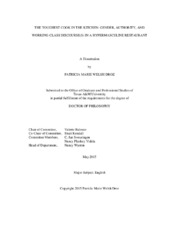| dc.description.abstract | The hypermasculine culture of haute cuisine has been traditionally limiting to women, who tend to leave the restaurant industry or stagnate in their professional growth. With interpretive and descriptive discourse analysis, the study both “spots” the discourse norms of a hypermasculine community of practice extant in a high-end kitchen on the Texas Gulf Coast and offers an interactional sociolinguistic frame analysis to reveal how one woman negotiates her gender and authority display within that context to effectively manage what is known as the double-bind: the challenge of being perceived as professional—exhibiting behaviors often linked to the sex-class male—and likeable—exhibiting behaviors often linked to the sex-class female, but indexical of professional inefficacy.
The study comes from approximately eight hours of transcribed audiovisual data coded for domain knowledge, linguistic traces of recurrent discourse patterns, and instances of frame-shifting, institutional gatekeeping, and subject positioning. In demonstrating how “domain,” the first component of a community of practice approach may be reconceptualized as a spectrum of information, I identify the discourse features of the kitchen, including their jargon, interactional patterns, and two commonly accessed interpretive discourses: the discourses of disadvantage and deviance. In the present context, disadvantage is constructed by talk of money troubles and worker exploitation; deviance is constructed with linguistic behaviors linked to hypermasculinity, including high levels of swearing, talk of substances, and body humor, which includes the aggression-potential of the male body and sexual humor often directed at female coworkers. The ideological discourses combine to account, in part, for the class-based anxieties of male interlocutors and their move to garner symbolic capital through hypermasculine behaviors.
This study also shows how one female manages the hypermasculine culture of her workplace and the double-bind by strategically maneuvering workplace frames, subject positioning, face needs, mitigation and aggravation strategies, and feminine and masculine speech varieties. Results suggest that the salience of workplace hypermasculinity impacts women’s negotiation of the double-bind. Women working in hypermasculine workforces can adopt the professional demeanor commonly associated with men, but still appear “feminine,” if they minimize engagement of hypermasculine codes. | en |


